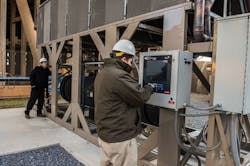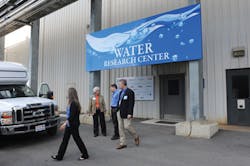By Jeff Gunderson
The thermoelectric power industry depends on significant quantities of freshwater withdrawals, mostly from surface water sources, and is among the highest users of water in the U.S. and worldwide. In the coming decades, the industry’s need for water is expected to grow substantially as booming trends in global population growth will drive increasingly greater demand for thermoelectric power. The prevalence of drought and mounting competition among industrial, municipal, and agricultural needs will further intensify these challenges, creating higher operational risks for thermoelectric power plants - especially those in water-stressed regions.
With these concerns in mind, the Electric Power Research Institute (EPRI), Southern Research, and Georgia Power, in collaboration with 14 other electricity generation companies, established the Water Research Center (WRC) at Georgia Power’s Plant Bowen to develop ways to reduce power plant water usage and improve the quality of water returned to the environment from power plants. The facility serves as a testing ground for pioneering innovations related to water management in thermoelectric power generation, enabling technology developers to evaluate promising systems under real-world conditions.
According to Georgia Power, the WRC came about as an extension of a pilot project that began in May 2010 at Plant Bowen to identify water reduction opportunities and enhance industry-wide water use efficiencies and power generation process water quality. Georgia Power envisioned that the WRC would provide a venue for developing and testing technologies to improve water efficiency by addressing withdrawal, consumption, and recycling throughout the power generation process.
Emphasizing seven distinct research focus areas, the WRC’s efforts are directed toward moisture recovery; cooling tower and advanced cooling systems; zero-liquid discharge; wastewater treatment; encapsulation process development and integration with solid landfill management; carbon technology water issues; and water modeling, monitoring, and best management practices.
“It’s important to recognize that these areas, while different, are very much interrelated,” said Richard Breckenridge, manager of EPRI’s Power Plant Water Management program and an active participant with research at the WRC. “Almost every research project will have an impact on or an association with another area. That’s why it’s crucial to approach each project holistically in terms of how it could work with other technologies to address more than one challenge at once.”
Driving the WRC’s programs are objectives to conserve water, minimize the amount of wastewater produced, and comply with increasingly stringent regulations, Breckenridge said. “The end goal is to decrease the amount of water that power plants withdraw and to return that water to the environment at a higher quality.”
Progress and Findings
Since its founding, the WRC has made significant headway in the testing and evaluation of progressive technologies related to wastewater treatment, solids handling, and brine management, including the thermal aspects of treatment processes.
The facility’s first two projects involved research on advanced cooling innovations, and specifically, technologies that employed dry cooling and that used water on an as-needed basis. “The goal was to reduce the amount of water required for cooling and to minimize water loss due to evaporation,” Breckenridge said. “Both technologies demonstrated significant water savings and were able to meet the required performance of the cooling unit with minimal sacrifice of efficiency. These two products are now commercially available.”
The WRC has also worked with cutting-edge membrane technologies such as forward osmosis and several other membrane systems that have shown great potential for addressing challenging wastewaters. Another field of research is aimed at finding ways to reduce energy use and costs associated with robust zero-liquid discharge (ZLD) treatment systems.
“With ZLD, we are testing some very progressive technologies that incorporate newer thermal evaporation techniques which are currently not used in the power industry,” Breckenridge said. “We are also exploring some alternative approaches to ZLD that may be able to lower the maintenance requirements and very high operating costs often associated with these systems.”
Research at the WRC is also focused on brine encapsulation and solidification of wastes. Kristen Jenkins, associate director of water research with Southern Research, said these efforts include the evaluation of contaminant leaching from concentrated brines. “Based on the concern that brines will release toxic metals after being placed in landfills, the emphasis is to understand the chemistry that drives metal leaching from these solids so that we can develop solutions that prevent it from occurring,” she said.
Meeting the New Effluent Limit Guidelines
Another significant area of WRC research is dedicated to complying with the new Effluent Limit Guidelines (ELGs) for steam electric power plants. Released by the U.S. Environmental Protection Agency (EPA), the new rule establishes limits on levels of toxic metals in wastewater discharges.
“Under treat and discharge, which is one of the pathways to compliance, we have studied physical-chemical treatments extensively, both in terms of meeting the new limitation standards with respect to mercury and as a pretreatment for biological processes that address selenium and nitrate reduction,” Jenkins said.
Research has also heavily emphasized the new regulations with respect to analyzing flue gas desulfurization (FGD) scrubber blowdown. “We are currently developing new technologies on the analytical side for monitoring metal concentrations in waste streams that would provide a streamlined alternative to sending samples to the lab for analyses,” Jenkins said. “With the new limits, there is now a need for online continuous monitoring of low-level metals in FGD wastewater.”
The testing and development of these technologies are also relevant to helping facilities comply with increasingly stringent state regulations. “States are lowering or adding water quality standards which are pushing facilities to higher levels of treatment including no-discharge options,” Jenkins said. “Over the last few years, water quality limits for dissolved parameters like sulfate and chloride have been added, and new limits have also been established for boron, which is difficult to treat. We’ve also seen mercury limits as low as 12 parts per trillion in some states.”
On the horizon, Jenkins said efforts will continue to focus on solids management, process cooling, and particularly, new technologies that can concentrate wastewater at lower energy.
About the Author: Jeff Gunderson is a correspondent for Industrial WaterWorld. He is a professional writer with over 10 years of experience, specializing in areas connected to water, environment and building, including wastewater, stormwater, infrastructure, natural resources, and sustainable design. He holds a master’s degree in environmental science and engineering from the Colorado School of Mines and a bachelor’s degree in general science from the University of Oregon.





